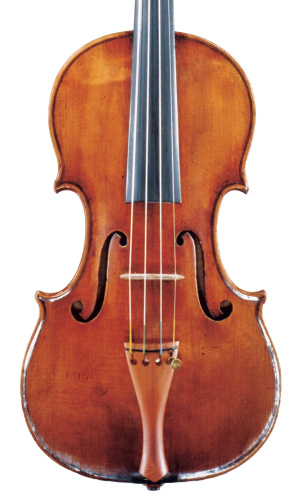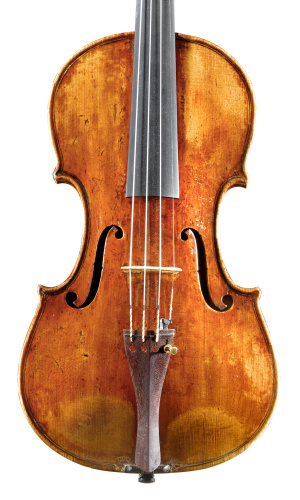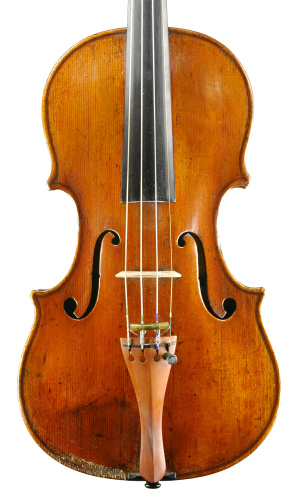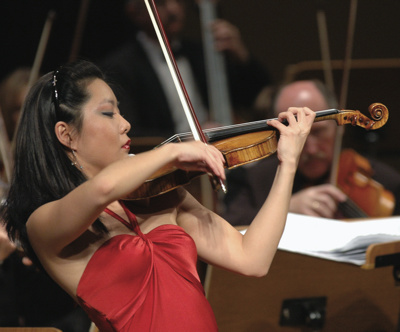
Violinist Yi-Jia Susanne Hou was recipient of the bank’s 1729 ‘del Gesù’ in 2003 and again in 2006. Photo: Yuri Colleoni
The instruments of the Canada Council Musical Instrument Bank are a hard working group. In a continual cycle of loans to promising young musicians, who compete every three years for the chance to use them, they have helped boost the careers of international stars such as James Ehnes, Lara St John, Martin Beaver, Susanne Hou, Alexandra da Costas and many others.
The bank was launched in 1985 with a bequest of CAN$100,000, which became its operating fund. Its first instrument, a David Tecchler cello of 1706, followed a couple of years later after a fundraising effort across Canada. Since then the collection has grown to its current number of 22 instruments and two bows, collectively worth millions of Canadian dollars.
Donations are key, as Joanne Larocque-Poirier, Head of the Prizes Section at the Canada Council, emphasizes: ‘This program runs on generosity. All of the instruments have been donated or loaned to the bank, or have been purchased with donated funds.’ The operating fund covers the cost of insurance and any significant restoration work, but it is not used for instrument purchase.
The bank’s official luthier, Ric Heinl of George Heinl and Co. in Toronto, scrutinises each potential instrument for its suitability. Sound is key, but condition, provenance and certification are all considered. Heinl also inspects the instruments after every three-year loan period and carries out any necessary repairs. Occasionally an instrument is taken out of the loan cycle for more major restoration, but this is rare.
The recipients of the instruments are decided via an open competition. Applicants submit audition tapes and the finalists are invited to Toronto to audition before a jury, which also interviews them about their career ambitions. Conflict of interest is taken seriously: owners of donated instruments cannot sit on the jury, and teachers of applicants are also barred. ‘We choose the jury based on who’s in the pool of applicants,’ says Larocque-Poirier. ‘We won’t stop the applicants from applying, we would just not go with that jury member if there was a conflict of interest.’
The jury ranks the winners, who are then invited to choose an instrument in strict order, effectively giving the highest-ranked ones the pick of the collection. A pool of applicants is held in reserve in case any winners decide not to take up the opportunity. ‘We’ve had a situation whereby the person who would have chosen last said, “I actually have access to a better instrument than I could potentially have with this ranking and therefore I will decline.”’
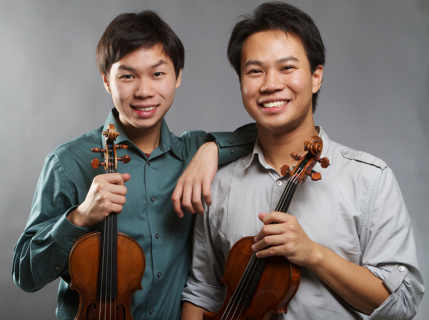
Brothers Timothy (left) and Nikki Chooi have been recipients twice each – winners are permitted to reapply up to four times. Photo: Donna Santos
The aim is to loan every instrument, and any new acquisitions are immediately offered to the reserve applicants rather than being held back until the next competition. All instruments must be returned after each loan period – although winners are able to reapply up to four times.
The Canada Council prides itself on establishing a close relationship with each of its musicians and it monitors rather than controls their activities. The winners may occasionally be required to perform at specific events, but the Canada Council does not always exercise this right. ‘We pretty much leave it up to them to decide where they’re going to go. They need to inform us of course so we can help promote [their concerts], but there are no conditions specifically about the number of performances or where they’re held.’ Winners must also sign an agreement that requires them to take the greatest care of their instrument and according to Larocque-Poirier mishaps are rare. ‘There have been minor nicks, but nothing serious has happened.’
Although the winners are chosen on merit rather than their ability to afford an instrument, Larocque-Poirier says that many of them come from relatively humble backgrounds. ‘Judy Kang grew up with a single mother and [her family] had a dream but didn’t have the means to purchase an instrument – it’s a compelling story about how much it meant to her… Some people joke that they sleep with their instruments – that’s how much they recognise the value of what they have.’
Does Larocque-Poirier ever encounter criticism of the Canada Council’s decision to keep its instruments in constant use? ‘It’s the opposite in fact. We keep hearing that people want them to be played. I’m approached quite frequently by more senior members of orchestras – sometimes they put a clause in their will to gift the instrument to the Canada Council Instrument Bank after their death or sometimes they will loan the instrument to the bank during their lifetime with the intention of gifting it in their wills. That’s a constant – the owners seem to want to have the instruments played.’
Highlights of the Musical Instrument Bank
By Philip J. Kass
I recently had the privilege of visiting the workshop of George Heinl in Toronto during the week that they were performing their annual inspection and maintenance of the Canada Council’s Musical Instrument Bank. It was a treat to walk into a room and be surrounded by great instruments – here a Strad violin, there a Strad cello and over there a Montagnana. In reflecting on that experience, I will share my thoughts on a few of the instruments that particularly stood out to me.
There are three Stradivari violins in the collection, the 1717 ‘Windsor-Weinstein’, the 1689 ‘Baumgartner’ and the 1702 ‘Taft’. Of these I have particular fondness for the ‘Taft’, an especially well-preserved work of an important period of transition for Stradivari, marked by his gradual abandonment of the Long Pattern around 1697–98. At this point he returned to experimentation with the pattern he had been using in the 1687–90 period, ultimately leading to the golden period, defined to many of us by the masterpiece that is the ‘Betts’ of 1704. The ‘Taft’ attracted a great deal of attention when it came on to the auction block at Christie’s New York in 2000, and many were pleased to know that it would both be frequently heard but also well cared for. The edges, corners and even the varnish retain much of their original crispness and patina, indicating that the fortunate musicians who have had the chance to perform on it since its acquisition have treated it with the same care that they would give to their own instruments.
I would be remiss if I didn’t also mention the collection’s Stradivari cello, the ‘Bonjour’ of circa 1690, which has a singularly breathtaking back fashioned out of slab-cut maple with a handsome curl that is similar to that one finds on such examples as the ‘Lord Aylesford’ of 1696. As with many Stradivari cellos of the earlier years, it followed the old large dimensions and as a result was reduced in size in 1860 to make it comfortable for the cellists of that time. In this case, the reduction was rather tastefully performed by the French luthier Claude Victor Rambaux.
The collection includes one Guarneri ‘del Gesù’, the ‘Baron Heath’, an early work from 1729. As with most of his violins at that time, Guarneri was seeking an aesthetic style independent from his father, while at the same time having made the discoveries in arching that make his violins so treasured by performers. The body still shows the influence of his father, while the scroll is all ‘del Gesù’. I feel a particular affinity to this work, made by the master as he was returning to his true calling, because of friendship with a succession of players who have played it, including Martin Beaver and both the Chooi brothers. It has spent many years recently at the Curtis Institute in Philadelphia, as Nikki Chooi and his brother Timothy have both had its use during their studies.
Two of the makers whose violins are in the collection are represented by very early works: Domenico Montagnana (a violin of 1715) and Francesco Pressenda (a violin of 1820). The Montagnana is a small violin and is crafted in his earliest style, a model derived from Amati. The Pressenda comes from a time when the acoustics of his work was set, even though he was still searching for his own personal style.
The collection possesses a violin made by Carlo Ferdinando Landolfi around 1750, which also stood out to me. Its deep red-orange varnish has had little past polishing and retains much of its fresh patina. In its construction it displays its maker’s almost Spartan economy of means, the spruce internals quickly finished but completely functional.
There are two violins by Gennaro Gagliano: the ‘Palmason’ of 1747 and the ‘Miller’ of 1768. The ‘Palmason’ is named for its last owner, a distinguished concert performer and teacher in Toronto, and clearly always received great care. Modeled after Amati, its scroll is in Gennaro’s best style, neatly carved in an almost Cremonese manner. The Fs are pleasingly fluted and the spruce and maple interior work is done very much in imitation of its model. Its arching is moderate, its channeling neat and precise, suggestive of the acoustic power often achieved by this master.
The ‘Miller’ is a later and less precisely finished instrument. Reverting to his usual practice, the internal work is here done with spruce and beech, the classic Neapolitan materials. Where the peg spacing on the ‘Palmason’ is done with Cremonese spacing, the ‘Miller’ has the classic Neapolitan groupings of the A and D pegs and the G and E pegs. Some elements of its style, notably the scroll model and arching shape, suggest that Gennaro’s nephew Giuseppe might have been working in the shop at that time.
The collection includes another Gagliano family instrument: a cello by Nicolò Gagliano II, bearing its original label of 1824. The work of Nicolò II, who was Nicolò I’s grandson and a son of Giovanni, is rarely encountered these days, partly because of a general weakness in the market for bowed strings at this stage of Neapolitan musical history but also because of widespread confusion about his exact identity. The general approach to construction takes its cue from the style of his father, although with less attention to finish. Curiously, while most Gagliano family cellos of the latter 18th century appear to have been crafted on the same form, this cello does not appear to have been created using any form, its ribs seemingly bent around the outline of its back.
Lastly, given my predilection for the Turin makers, I would be remiss not to mention a nice 1730 cello by Gio Francesco Celoniato. Most of Celoniato’s instruments date from a brief period, roughly mid-1720s to the mid-1730s, and were probably made for the court. The materials used were probably inexpensive for their time, poplar for the back and sides and three panels of pine-like spruce for the top. Its measurements are on the small side that was preferred for cellos by those years, as is reflected by the work of his contemporaries in Milan and Piacenza. Celoniato made a fair number of cellos, a reminder that Turin was a center not just for fine violin performance (Somis and Pugnani) but also for cello performance (Lanzetti, Spotorno and Chiabrano).
Philip J. Kass is an expert on classical violin making and has contributed extensively to the Journal of the Violin Society of America, The Strad magazine and the New Grove Dictionary of Music.
All photos courtesy of the Canada Council for the Arts. Find out more about the Musical Instrument Bank.
